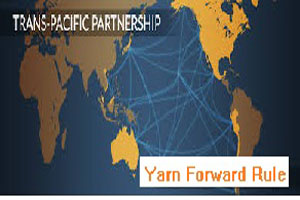
Yarn Forward rule to have major effects on signatory countries such as Vietnam
YarnsandFibers News Bureau 2015-05-13 11:00:00 – VietnamUnited States led trade agreement Trans-Pacific Partnership (TPP) which involves twelve countries, is presently under negotiation. A key part of the proposed TPP is a rule known as “yarn forward†which would require that only fabric produced from yarn made by a TPP country would qualify for the trade agreement’s duty-free status. The rule is intended to ensure that the trade benefits of the TPP only apply to signatory countries rather than outside players such as China. However, the rule also likely to have major effects on signatory countries, such as Vietnam.
Upon completion, the TPP trade area would comprise a region with US$28 trillion in economic output, making up around 39 percent of the world’s total output. If the TPP is successfully implemented, tariffs will be removed on almost US$2 trillion in goods and services exchanged between the signatory countries. Thus, Vietnam has much to gain from the implementation of the trade agreement, including drastically reduced tariffs in some of the world’s largest markets.
Yarn forward could have serious effects for countries like Vietnam which is currently a key global garment manufacturing location. Its factories often use Chinese-made fabrics in their products, and China is not a part of the TPP. In fact, around eighty-five percent of Vietnamese textile and garment companies outsource from foreign partners. So for Vietnam, to be eligible for TPP benefits such as lower tariffs in the US, it will have to develop its own local fabric industry or constrain itself to only importing fabric from another TPP country.
Vietnam is currently working to have the “yarn forward†rule removed, or its implementation delayed, from the TPP. A number of other countries have also pledged their support to Vietnam. Other actions that Vietnam has taken show that it may be ready to acquiesce to yarn forward, and the country has so far expressed fairly consistent support for the trade agreement, since it will allow many of its other products market access to some of the world’s biggest economies. Therefore, it seems that the rule will not be a fatal roadblock to the TPP’s finalization. The US Trade Representative (USTR) has also stated that the US will not pull back from its demand for yarn forward.
A number of Vietnamese companies are already starting up, or expanding, their own fiber manufacturing operations in order to not be left behind when the TPP is finally implemented. Key companies include the Century Synthetic Fiber Corporation (CSFC), Thanh Cong Joint Stock Co (TCM), and the Vietnam Textile and Garment Corporation (Vinatex).
Additionally, in a further bid to enhance the competitiveness of the country’s fiber manufacturing industry, Vietnam’s Ministry of Industry and Trade has proposed levying a two percent import tax on polyester staple fiber (PSF). Currently PSF imports are not subject to tax.
While yarn forward may have some deleterious impacts upon Vietnam, US textile makers are keen for the rule to be implemented. This is because they believe that the rule will help to constrain China and Vietnam’s entrance into the US market. In turn, US textile makers also believe that the rule will make Vietnam more attractive to American textile industry investment.
This is not the first time that a “yarn forward†principle has been pushed by the United States. It was also used in the Central American Free Trade Agreement (CAFTA), which stated that the yarn, fabric, sewing thread, and the final garment itself must be made either in the United States or one of the six Caribbean or Central American countries party to the agreement. Manufacturers have found the yarn forward rule to be a strong tool in ensuring their competitiveness on the world market. The TPP has garnered strong support from many US manufacturers.
In their fight against yarn forward, countries like Vietnam have joined forces with retailors such as Walmart and Target in order to push for more flexibility in the rule. The USTR appears to be somewhat receptive to these voices and, in its most recent “summary of objectivesâ€, it has included a “short supply†rule. This rule would allow raw materials “not commercially available in the United States or other TPP countries to be sourced from non-TPP countries and used in the production of apparel in the TPP region without losing duty preference.â€
The USTR said that this flexibility will be limited, others have criticized the rule as once again opening the door to China. If Chinese goods are allowed into Vietnam and exported to the US, then China will be accruing the benefits of the TPP without having to give up anything itself. This problem can be seen in the rules of origin related to other goods, for example some have rules stating that up to 65 percent of the product can be manufactured outside of the country, but the product can still be deemed as having been made within that country. In reaction to this criticism, the USTR has strongly expressed its belief that the short supply rule will not allow countries to be able to launder their products through TPP nations.
Meanwhile, businesses have start wisely planning for all eventualities and ensure to take best advantage of TPP trade agreement.
Market Intelligence
Ask for free sample Report

experience
Customer Base
dedicated team
Countries Served Worldwide









